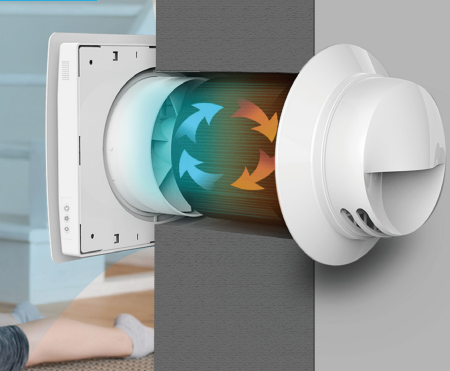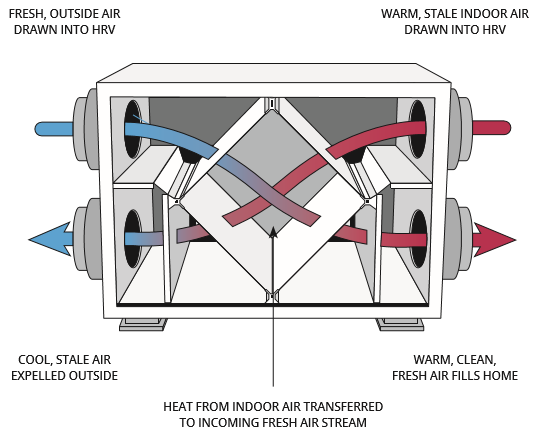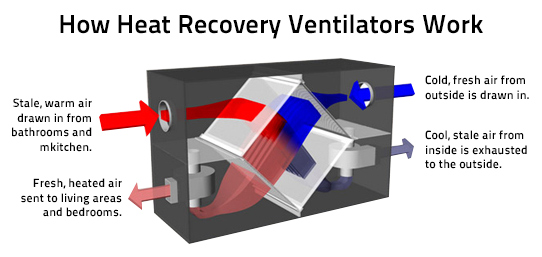A Simple Guide to HRV Upkeep
Wiki Article
The All-Inclusive Guide to the Uses of Heat Recovery Ventilation in Modern Structures
Heat Recovery Ventilation (HRV) systems stand for a significant development in constructing technology (HRV Heat Recovery Ventilation). They provide an approach for trading stagnant indoor air with fresh outdoor air while minimizing power loss. This method not only enhances interior air quality yet additionally adds to power effectiveness in both household and industrial buildings. Comprehending the different applications and benefits of HRV can disclose its essential function in contemporary layout and sustainability efforts. The effects of this technology deserve checking out betterRecognizing Heat Recovery Ventilation Solutions

Although several modern-day structures focus on power effectiveness, recognizing heat recovery air flow (HRV) systems is crucial for maximizing interior air quality and minimizing power consumption. HRV systems function by transferring warm from stale indoor air to incoming fresh air, properly keeping comfy interior temperature levels while lessening energy loss. These systems contain a heat exchanger, fans, and ductwork that help with the circulation of air. During wintertime, HRV systems record and reuse heat from the outward bound air, while in summertime, they can assist cool inbound air. By continuously exchanging air, HRV systems additionally lower moisture and the concentration of indoor pollutants. Proper setup and maintenance of HRV systems are important for their efficiency and efficiency in improving general structure performance and convenience.
Benefits of Heat Recovery Ventilation
Heat recovery ventilation systems provide countless advantages that boost both power performance and indoor air high quality in contemporary structures. By catching and recycling power from exhaust air, these systems greatly decrease cooling and heating costs, leading to lower power consumption. Moreover, they preserve a consistent flow of fresh exterior air, lessening the danger of interior air pollutants and allergens. This continuous exchange assists control moisture levels, preventing mold and mildew growth and ensuring a healthier living atmosphere. Furthermore, HRV systems add to sustainability objectives by lowering overall carbon impacts. Their capacity to enhance ventilation without compromising thermal convenience makes them a beneficial enhancement to contemporary building layout, advertising both economic and eco-friendly benefits.Applications of HRV in Residential Structures
As homeowners significantly prioritize energy effectiveness and interior air high quality, the applications of warm healing air flow (HRV) systems in residential buildings have become much more prevalent. HRV systems are particularly advantageous in snugly sealed homes, where keeping fresh air circulation is necessary for avoiding moisture buildup and indoor toxins. They properly transfer heat from outbound stale air to incoming fresh air, decreasing power costs connected with heating & cooling. In addition, HRVs can improve convenience degrees by managing moisture and temperature. They are also adaptable for various domestic styles, consisting of single-family homes and multi-unit structures. In general, incorporating HRV systems sustains sustainable living practices while making certain a much healthier interior atmosphere for occupants.HRV in Commercial and Commercial Setups
In business and industrial settings, the execution Your Domain Name of warm recovery ventilation (HRV) systems has become progressively critical for optimizing energy efficiency and maintaining air top quality. These systems properly move heat from exhaust air to incoming fresh air, minimizing the requirement for added heating or cooling. This not only reduces energy expenses however additionally adds to sustainability campaigns. Industries such as production, warehousing, and workplace buildings profit substantially from HRV systems, as they help regulate temperature level and moisture levels, making certain a comfy and efficient atmosphere. HRV systems aid in eliminating contaminants and excess wetness, enhancing interior air quality. As policies around air high quality come to be more stringent, the adoption of HRV technology is most likely to grow, making it a vital element of modern-day commercial and industrial framework.Future Fads in Heat Recovery Ventilation Modern Technology

Regularly Asked Concerns
Just How Does Heat Recovery Ventilation Influence Indoor Air Top Quality?
Heat recovery ventilation significantly enhances indoor air top quality by continuously exchanging stagnant indoor air with fresh outdoor air while recuperating power. This procedure decreases pollutants, maintains excellent moisture levels, and guarantees a much healthier setting for owners.Can HRV Systems Be Mounted in Existing Buildings?
HRV systems can certainly be installed in existing structures. Retrofitting may call for alterations to ductwork and ventilation designs, yet it significantly boosts energy efficiency and indoor air top quality, making it a feasible choice for older structures.What Maintenance Is Required for HRV Equipments?

Are There Particular Climates Where HRV Is Extra Efficient?
Heat recovery ventilation systems are particularly efficient in environments with substantial temperature differences in between seasons. These systems maximize energy performance by recouping warmth from exhaust air, making them excellent for both cold and reasonably cozy environments.How Do HRV Systems Affect Energy Bills?

Report this wiki page